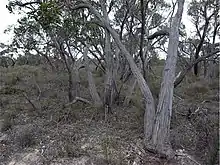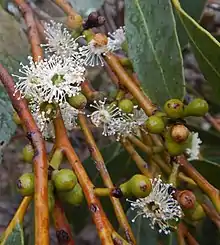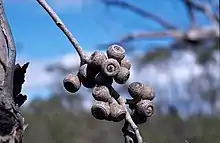| Desert stringybark | |
|---|---|
 | |
| Eucalyptus arenacea in the Little Desert National Park | |
| Scientific classification | |
| Kingdom: | Plantae |
| Clade: | Tracheophytes |
| Clade: | Angiosperms |
| Clade: | Eudicots |
| Clade: | Rosids |
| Order: | Myrtales |
| Family: | Myrtaceae |
| Genus: | Eucalyptus |
| Species: | E. arenacea |
| Binomial name | |
| Eucalyptus arenacea | |
Eucalyptus arenacea, commonly known as the desert stringybark[3] or sand stringybark,[4] is a tree or a mallee that is endemic to south-eastern Australia. It has rough bark to the thinnest branches, lance-shaped or curved adult leaves, club-shaped flower buds arranged in groups of between seven and fifteen, white flowers and hemispherical to more or less spherical fruit.


Description
Eucalyptus arenacea is a tree with several to many stems or a robust mallee, grows to a height of 3–10 metres (10–30 ft) and forms a lignotuber. It has rough, fibrous and stringy bark on its trunk and to the thinnest branches. Leaves on young plants and on coppice regrowth are arranged in opposite pairs and are egg-shaped, 35–85 mm (1–3 in) long and 30–40 mm (1–2 in) wide. Adult leaves are shiny green, arranged alternately, lance-shaped or curved, 70–120 mm (3–5 in) long and 15–40 mm (0.6–2 in) wide on a petiole 10–25 mm (0.4–1 in) long. The flowers are borne in groups of between seven and fifteen in leaf axils on a peduncle 5–18 mm (0.20–0.71 in) long, the individual buds on a pedicel 2–5 mm (0.079–0.20 in) long. The mature buds are oval to club-shaped, 5–6 mm (0.20–0.24 in) long and 3–5 mm (0.1–0.2 in) wide with a rounded or conical operculum. Flowering mainly occurs between December and January and the flowers are white. The fruit is hemispherical to a truncated sphere, 4–9 mm (0.16–0.35 in) long and 7–12 mm (0.3–0.5 in) wide on a pedicel up to 3 mm (0.1 in) long.[3][4][5]
Taxonomy and naming
Eucalyptus arenacea was first formally described in 1988 by Julie Marginson and Pauline Ladiges and the description was published in Australian Systematic Botany.[6] The specific epithet (arenacea) is a Latin word meaning "of sand".[7]
Distribution and habitat
Desert stringybark grows on pale-coloured sandhills and on sandplains between Keith, Pinaroo and Bordertown in the Ninety Mile Desert in South Australia and in the Little Desert and Big Desert areas of Victoria.[4][5]
See also
References
- ↑ Fensham, R.; Collingwood, T.; Laffineur, B. (2019). "Eucalyptus arenacea". IUCN Red List of Threatened Species. 2019: e.T133377899A133377901. doi:10.2305/IUCN.UK.2019-3.RLTS.T133377899A133377901.en. Retrieved 19 November 2021.
- ↑ "Eucalyptus arenacea". Australian Plant Census. Retrieved 4 March 2019.
- 1 2 Brooker, M. Ian; Slee, Andrew V. "Eucalyptus arenacea". Royal Botanic Gardens Victoria. Retrieved 4 March 2019.
- 1 2 3 Nicolle, Dean (2013). Native Eucalypts of South Australia. Adelaide: Dean Nicolle. pp. 210–211. ISBN 9780646904108.
- 1 2 "Eucalyptus arenacea". Euclid: Centre for Australian National Biodiversity Research. Retrieved 4 March 2019.
- ↑ "Eucalyptus arenacea". APNI. Retrieved 4 March 2019.
- ↑ Brown, Roland Wilbur (1956). The Composition of Scientific Words. Washington, D.C.: Smithsonian Institution Press. p. 678.
